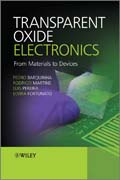
Transparent electronics: from materials to devices
Martins, Rodrigo
Fortunato, Elvira
Barquinha, Pedro
The book will begin with a summary of the concepts of transparentelectronics before discussing the role of active and passive applications.Then it will review the history of thin film transistors and current andemerging technologies. Further chapters will cover oxide semiconductors,dielectric materials and applications, including the groundbreaking papertransistors and memory developed by the authors themselves. Finally, theauthors will give an overview of the future of transparent electronics. INDICE : Preface xiii Acknowledgments xv 1 Introduction 1 1.1 Oxides andTransparent Electronics: Fundamental Research or Heading Towards CommercialProducts? 1 1.2 The Need for Transparent (Semi) Conductors 3 1.3 Reaching FullTransparency: Dielectrics and Substrates 5 2 N-type Transparent SemiconductingOxides 9 2.1 Introduction: Binary and Multicomponent Oxides 9 2.1.1 BinaryCompounds: the Examples of Zinc Oxide and Indium Oxide 9 2.1.2 Ternary andQuaternary Compounds: the Examples of Indium-Zinc Oxide andGallium-Indium-Zinc Oxide 12 2.2 Sputtered n-TSOs: Gallium-Indium-Zinc OxideSystem 16 2.2.1 Dependence of the Growth Rate on Oxygen Content in the Ar+O2Mixture and Target Composition 16 2.2.2 Structural and MorphologicalProperties 18 2.2.3 Electrical Properties 22 2.2.3.1 Effect of oxygen contentin the Ar + O2 mixture 22 2.2.3.2 Effect of composition (binary, ternary andquaternary compounds) 24 2.2.3.3 Effect of annealing temperature 27 2.2.3.4Additional considerations about the conduction mechanisms in oxidesemiconductors 30 2.2.3.5 Effect of thickness (ds) 39 2.2.3.6 Electricalstability measurements 39 2.2.4 Optical Properties 41 2.2.4.1 Generalconsiderations about the optical measurements 41 2.2.4.2 Effect of oxygencontent in the Ar + O2 mixture 43 2.2.4.3 Effect of composition (binary andmulticomponent oxides) 44 2.2.4.4 Effect of annealing temperature 46 2.3Sputtered n-TSOs: Gallium-Zinc-Tin Oxide System 49 2.4 Solution-processedn-TSOs 51 2.4.1 ZTO by Spray-pyrolysis 51 2.4.2 ZTO by Sol-gel Spin-coating 522.4.3 GIZO Sol-gel by Spin-coating 52 3 P-type Transparent Conductors andSemiconductors 63 3.1 Introduction 63 3.2 P-type Transparent Conductive Oxides64 3.3 Thin Film Copper Oxide Semiconductors 66 3.3.1 Role of Oxygen in theStructure, Electrical and Optical Performance 70 3.3.1.1 Structure evaluation70 3.3.1.2 Electrical properties evaluation 71 3.3.1.3 Optical propertiesevaluation 74 3.4 Thin Film Tin Oxide Semiconductors 75 3.4.1 Structure,Composition and Morphology of Tin Oxide Films 79 3.4.1.1 Structure evaluation79 3.4.1.2 Morphology evaluation 84 3.4.2 Electrical and Optical Properties ofTin Oxide Films 84 3.4.2.1 Electrical properties evaluation 84 3.4.2.2Capacitance measurements 89 3.4.2.3 Optical properties evaluation 92 4 GateDielectrics in Oxide Electronics 101 4.1 Introduction 101 4.2 High-kDielectrics: Why Not? 102 4.3 Requirements 103 4.4 High-k DielectricsDeposition 106 4.5 Sputtered High-k Dielectrics in Oxide TFTs 106 4.6 HafniumOxide 107 4.6.1 Multicomponent Co-sputtered HfO2 Based Dielectrics 117 4.6.2Multicomponent Dielectrics from Single Target 126 4.7 Tantalum Oxide (Ta2O5)130 4.7.1 Multicomponent Ta2O5 Based Dielectrics 133 4.8 MultilayerDielectrics 138 4.9 High-k Dielectrics/Oxide Semiconductors Interface 141 4.10Summary 146 5 The (R)evolution of Thin-Film Transistors (TFTs) 155 5.1Introduction: Device Operation, History and Main Semiconductor Technologies155 5.1.1 Device Structure
- ISBN: 978-0-470-68373-6
- Editorial: John Wiley & Sons
- Encuadernacion: Cartoné
- Páginas: 360
- Fecha Publicación: 30/03/2012
- Nº Volúmenes: 1
- Idioma: Inglés
